REVIEWER'S NOTE: This is a two-part review – the first part is a build comparison of the shipping version of the EDGETAC NiteCore Defender Infinity with the pre-production version I reviewed previously. The Second part is a detailed comparison of both lights to other lights (updated from my pre-production review). Both NiteCore lights were provided free of charge by EDGETAC for review.
To see comparisons to a wider range of 1AA lights, please see my new:
Multi-stage 1AA Review - Part III: Runtimes, beamshots & more!
UPDATE 1/9/08: Added Olight T15 Q5 to the runtime comparisons in Part II.
PART I: Shipping vs. Pre-production Build Comparison
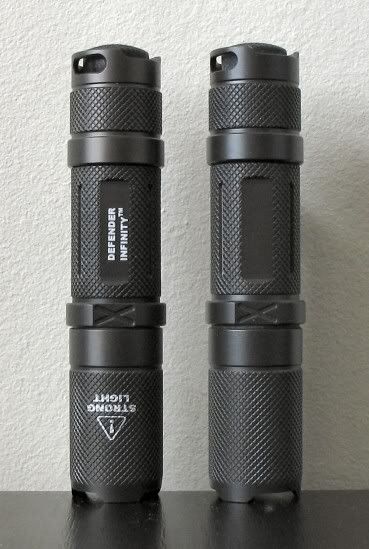
As you can see, the lights have the same dimensions. The shipping version has a slightly darker anodized finish, with identifying labels all around the light. All parts are interchangeable between the two lights.
Here's what came in the package (Shipping first, Pre-Production second)
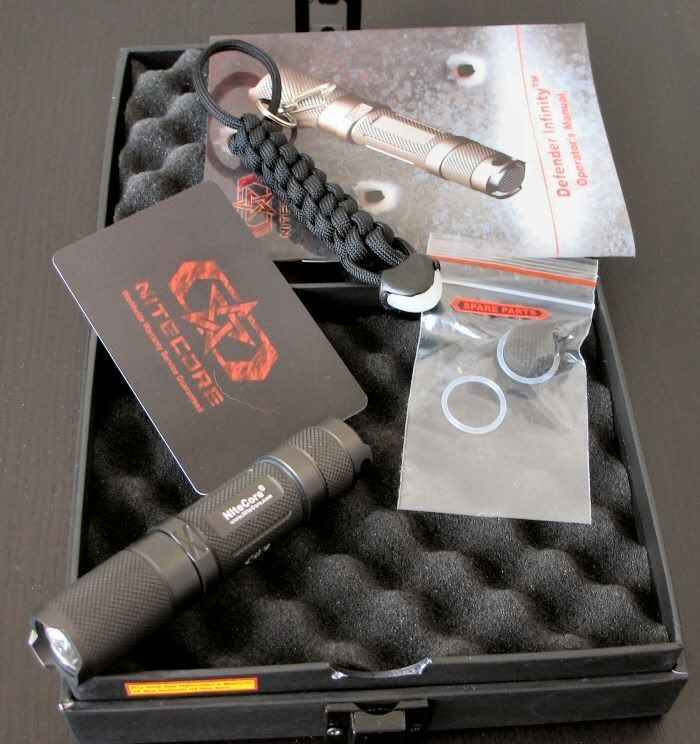
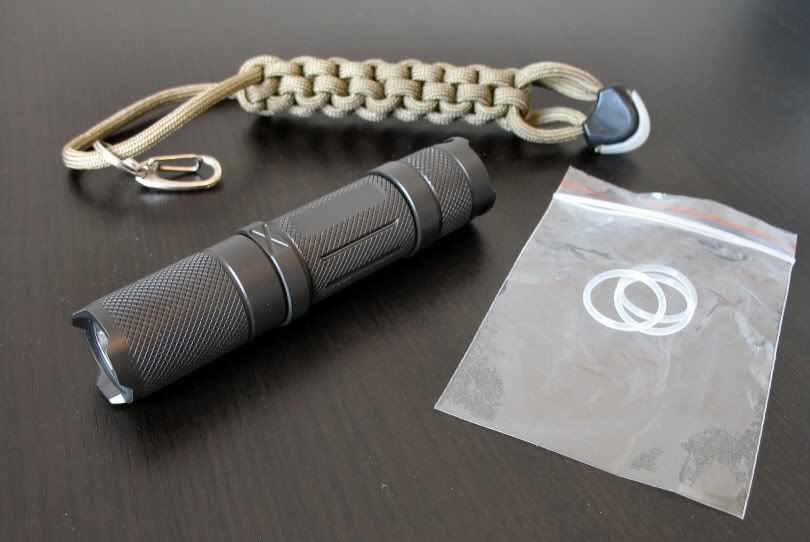
The Shipping version comes in a nice box with foam insulation and warranty card, manual, tactical lanyard, and spare parts. Quality of the lanyard is similar to my pre-production version. Here are a few other views of light (again, Shipping first followed by Pre-production).
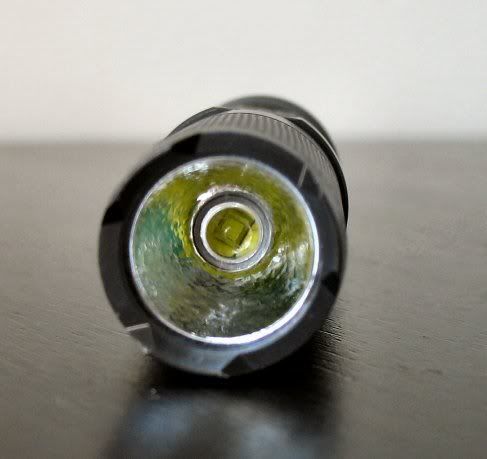

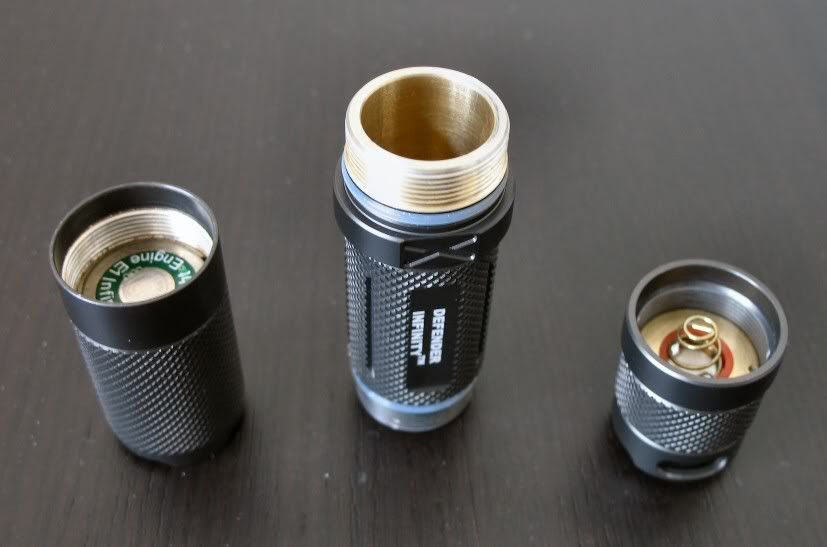
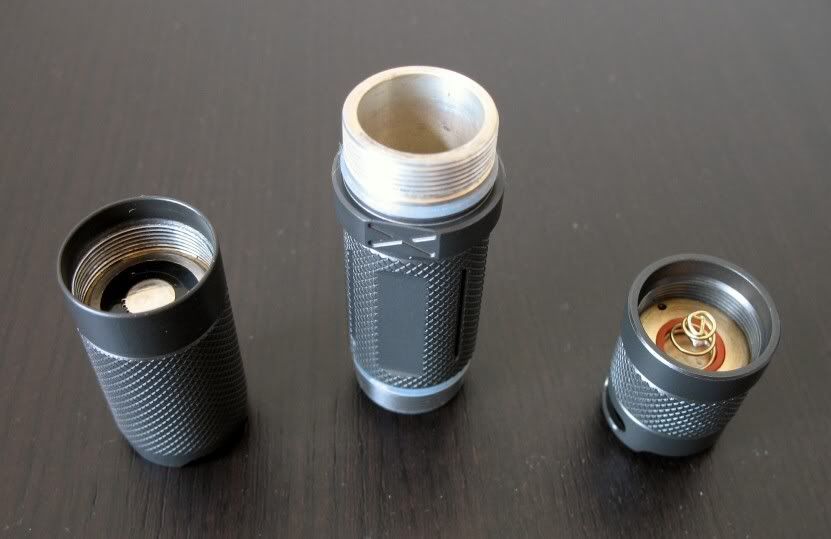
Build quality seems roughly identical between the lights, although the contact disc in the head is clearly different. The Shipping version is slightly stiffer when tightening the head the last couple of turns on the body, which seems to be due to a slightly wider o-ring on the shipping version. It doesn't affect function in my case.
Both lights shipped quite "dry" – little or no lube on the threads and o-rings. I always add a little nyogel to the o-rings, but be careful in lubing the threads in the head. I experienced mode switching errors when I recently tried a little nyogel 760G lube on the threads on my pre-production version (which thankfully disappeared once I thoroughly cleaned it off). Regular thread cleaning with deoxit might be the best course of action.
Feature set is the same for both lights, although switching time has been reduced from 1 sec to 0.5 sec (i.e. how long you have to perform a loosen/tighten switch of the head to change modes). If you are too slow on the switch, the light will simply move between max and user defined modes. See below for a greater description of the interface.
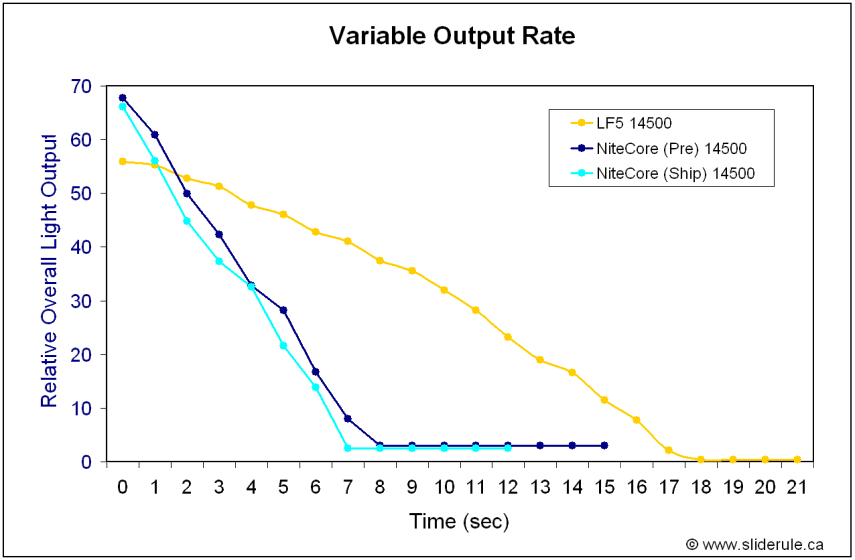
Ramping time is similar between the lights, maybe ~1 sec faster on the Shipping version (again, see further below for a discussion in comparison to the Liteflux)
Comparison of beamshots (Shipping on left, Pre-production on right, both on AW 14500)
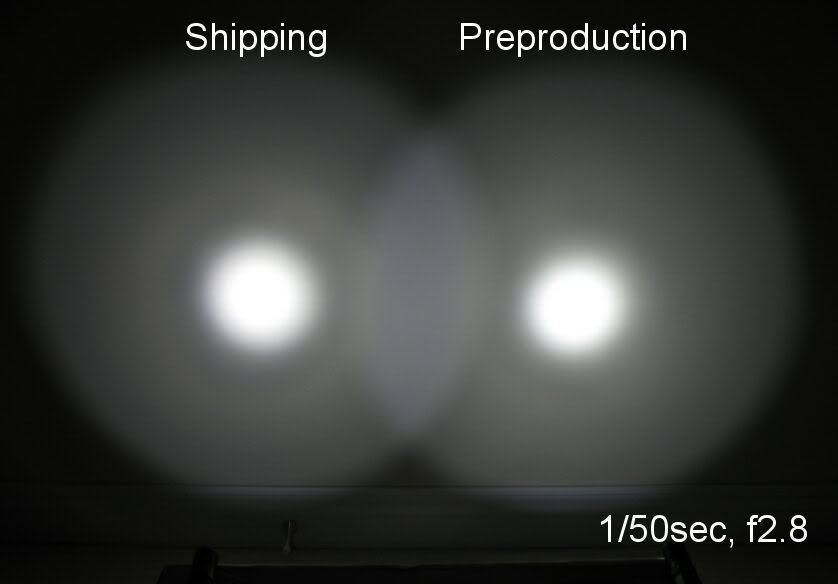

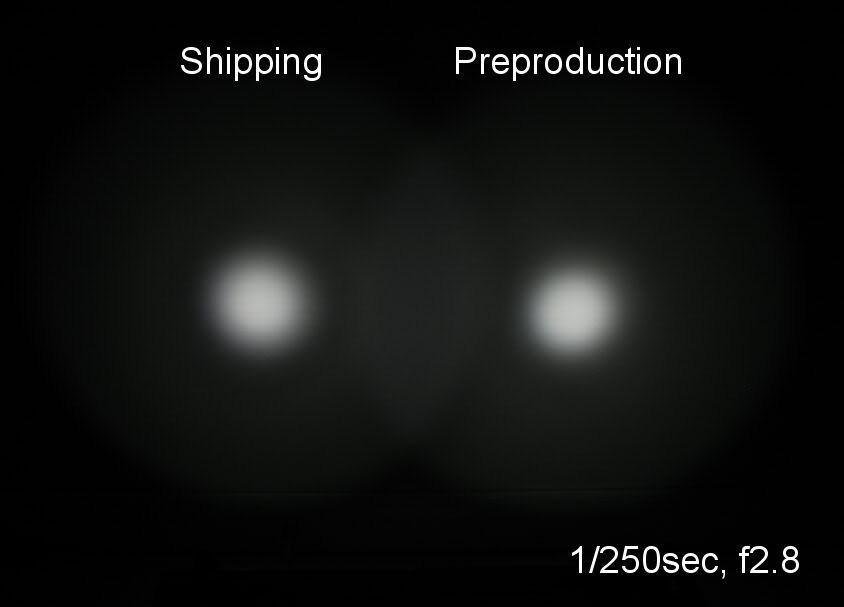
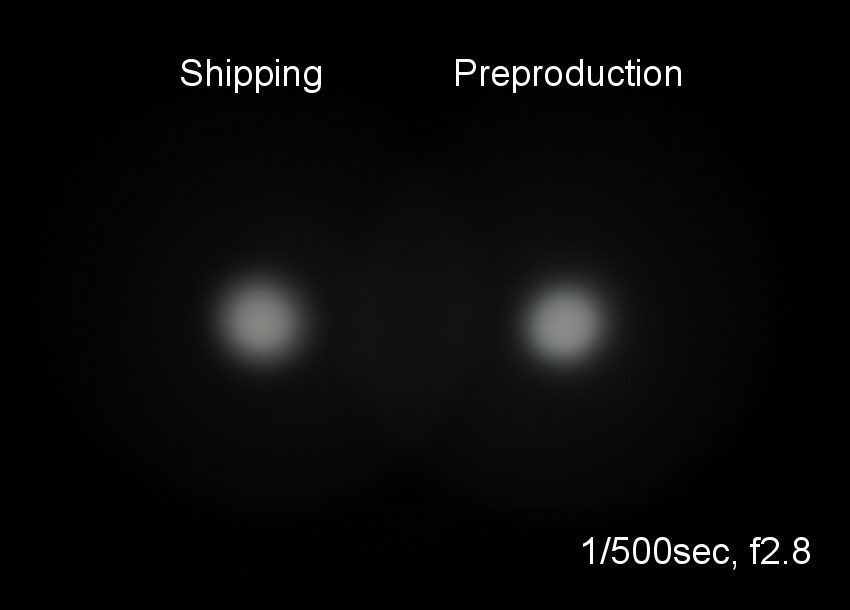
Beam profiles are similar, both a premium white tint, although the dark ring around the corona is slightly more pronounced on my Shipping version compared to the Pre-production sample. This is likely due to a slight height difference of the pill inside the head.
Regulated overall output and runtimes are similar, but there is a difference in initial output between the Pre-Production and Shipping versions (see comparison runtimes below for greater discussion of output/runtime differences).
PART II: Comparison of the NiteCores to other lights
For this part of the review, the Shipping and Pre-production NiteCores will be compared to the Fenix L1DCE Q5 and Liteflux LF5. The Olight T15 (Q5) has just been added to the output/runtime graphs.
The contenders:
From left to right: Pre-Production Nitecore Defender Infinity, Fenix L1DCE Q5, Liteflux LF5. Not shown is the Olight T15 Q5
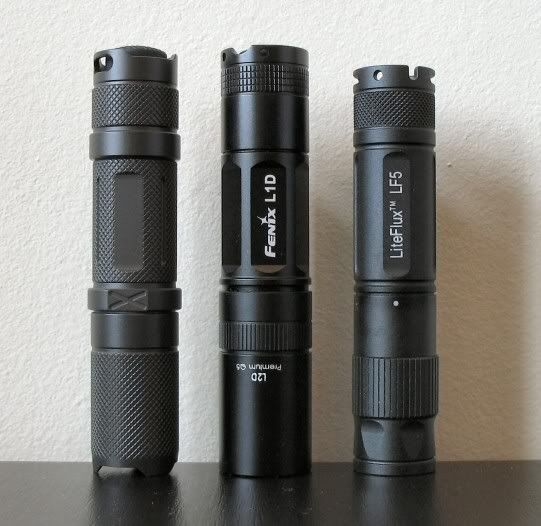
Beamshots:
On 2650mAh NiMH (on Max/Turbo/100%) at ~0.5m from a white wall.
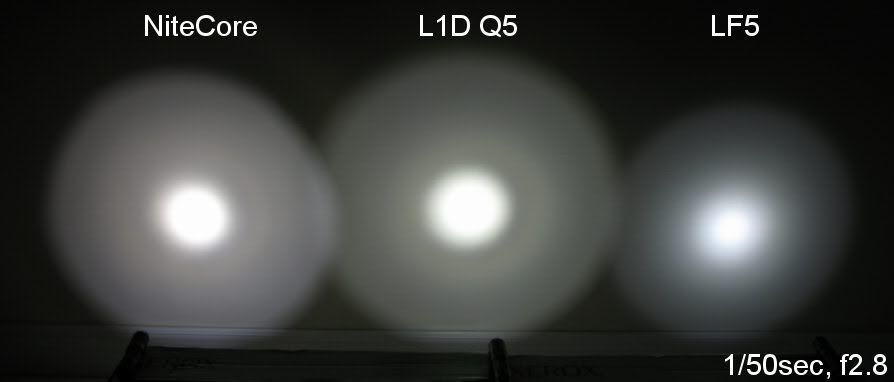

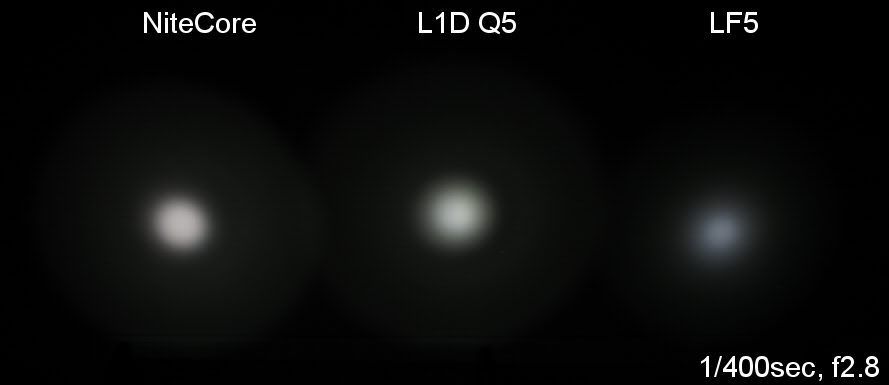
The camera is accentuating the tint differences a bit. The Nitecore Q5 is a premium white, slightly on the cool side. The L1D Q5 is also a premium tint, slightly warm. The LF5 uses a SSC emitter, and is definitely cooler. The Nitecore has a slightly smaller overall spillbeam than the Fenix, but still larger than the Liteflux.
Method: All my output numbers are relative for my home-made light box setup, a la Quickbeam's FR.com method. My relative overall output numbers are typically similar to his, although generally a little lower. You can directly compare all my review graphs - i.e. an output value of "10" in one graph is the same as "10" in another.
Throw values are the square-root of lux measurements taken at 1m using a light meter.
Summary Chart

Note: The chart has only the Pre-production NiteCore at the moment - I will update the chart with the Shipping results shortly.
For more detailed comparisons, please scroll down to the runtimes below. For additional comparison purposes, here are the results of a "ceiling-bounce" test in a small windowless room, with my light meter on the floor near the base of the light (which is shining upward in candle-mode), all on 2650mAh NiMH:
L1DCE Q5: 4.1 lux
L2DCE Q5: 7.1 lux
Nitecore (Pre-Production): 5.1 lux
To see more about the Fenix L2DCE Q5, please see my detailed review here:
Fenix L2D Q5 vs R100, R80, Q2, P4 Comparison Review: RUNTIMES+
Runtimes:
Note: The NiteCore does NOT have defined medium/low modes – rather, the light uses a continuously variable digitally-controlled brightness level. For the purposes of this review, I've manually set the Pre-Production Nitecore to ~85%, ~50% and ~15% max output in order to compare to the Fenix and Liteflux lights. These levels are completely arbitrary on my part, and are simply to facilitate comparison between the lights.
Turbo/Max/100% mode on 2650mAh NiMH
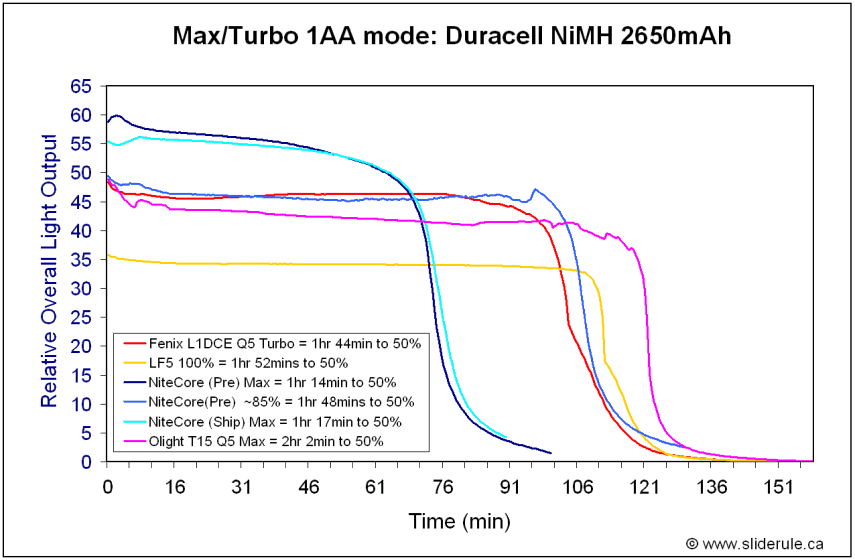
Turbo/Max/100% mode on eneloops (~2100mAh)
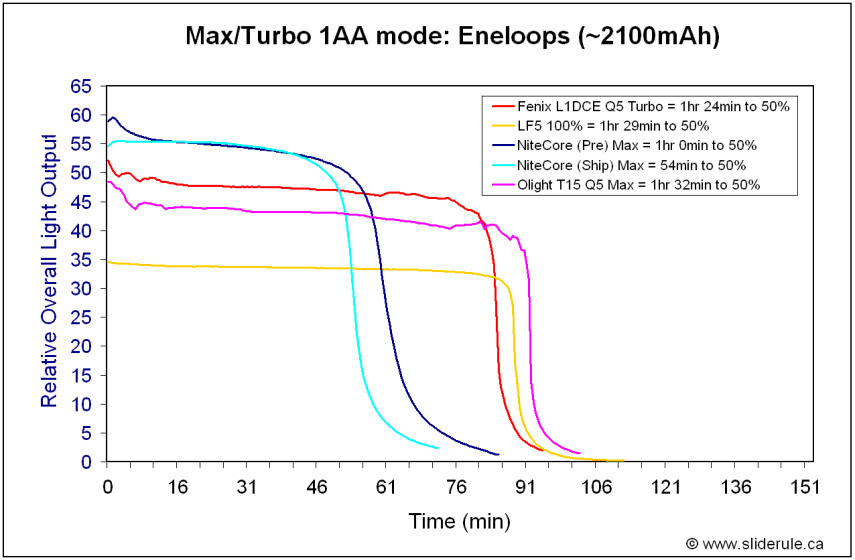
Turbo/Max/100% mode on Energizer e2 lithium (L91)
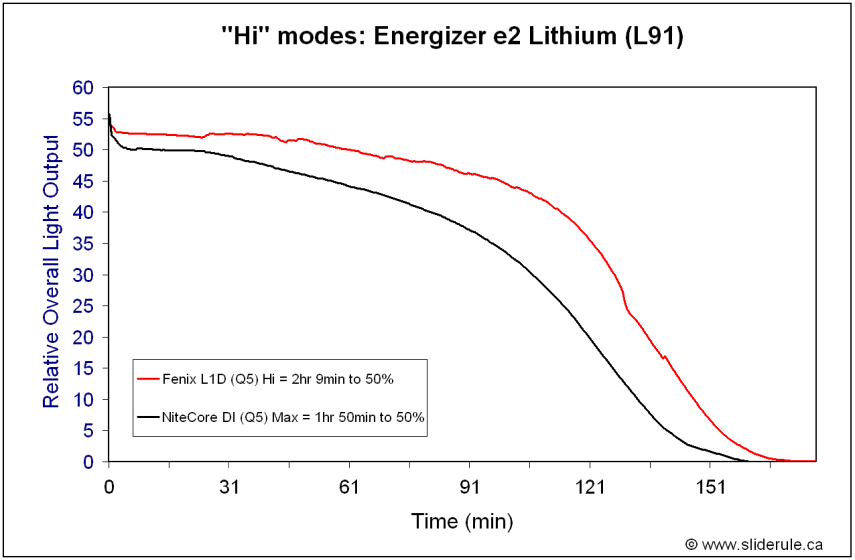
Turbo/Max/100% mode on Duracell Alkaline

"Medium" modes on Duracell Alkaline
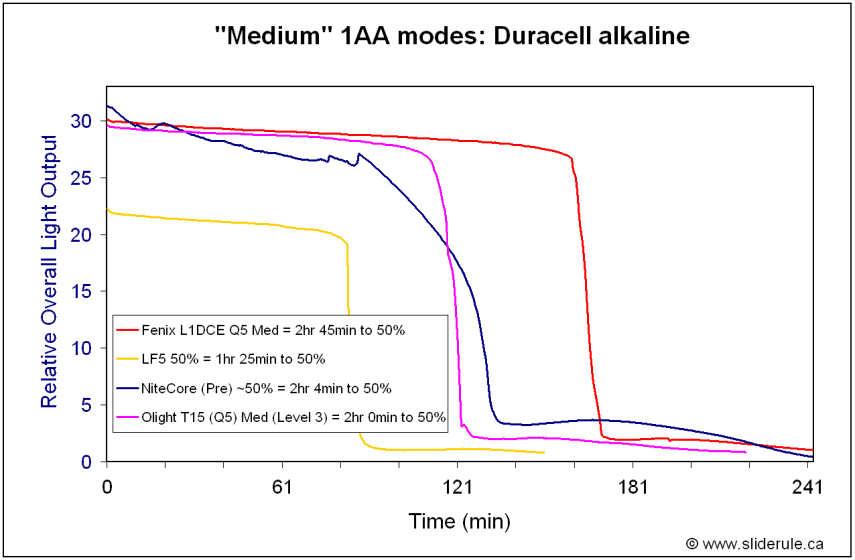
"Low" modes on Duracell Alkaline

Hi mode on AW protected 14500
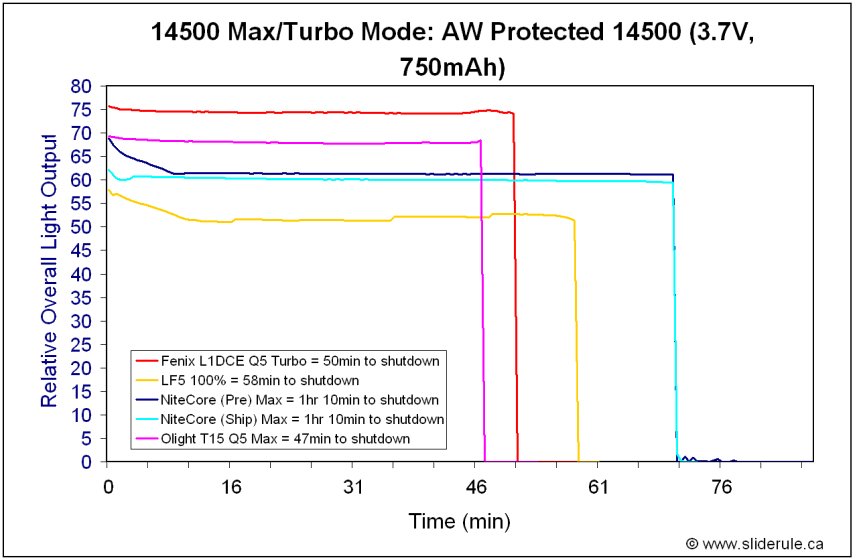
Medium modes on AW protected 14500
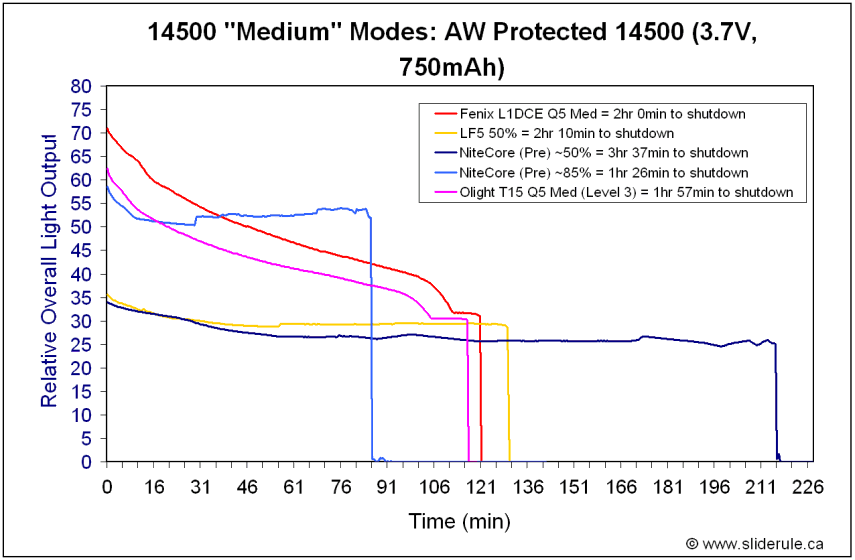
Output/runtime observations:
General observations:
Digital control:
EDGE Tactical confirms that the light uses PWM, and the frequency is >1 kHz. I'm thinking it's likely considerably above, since I can measure it with my setup, or detect its presence by eye.
Interface:
The Nitecore allows you to set your low mode through a continuously variable brightness mechanism similar to Liteflux (but easier to use and more linear, as described below). The light is controlled by a forward clicky switch with momentary on, followed by a click to lock-on. Sequence is as follows:
Variable Output ramping time
Below is a graph comparing my Pre-Production and Shipping NiteCores to the Liteflux LF5, which has a similar mechanism. For this test, I measured output at 1 sec intervals in my lightbox as the lights underwent a ramp down from max to min, on 14500.

The NiteCore is far superior in my view since light brightness is adjusted in a visually linear manner over the 7-8 sec time frame. The Liteflux takes over twice as long, but has a curvilinear sequence that's very difficult to gauge visually.
To explain what I mean by that, consider if you wanted to manually reach quartile outputs of 75%, 50%, 25% and 0% with both lights. For NiteCore it takes approximate 2 secs to reach each level, and you can thus predict how long it will take you to get to any point. For the Liteflux, it will take about 7-8 secs to reach 75%, then 4-5 secs to reach 50%, about 3 secs to reach 25%, and 2 secs to reach 0%. This accelerating rate makes it hard to accurately gauge when the desired low mode will be reached (in fact, for the first few secs, you aren't even sure if anything is happening!). Coupled with the multiple SW switching required by the Liteflux, the NiteCore is a model of simplicity in comparison. :thumbsup:
Build, Machining and Anodizing
Body/Head/Tailcap
Conclusion:
I've been EDCing my Pre-Production NiteCore since I received it, and my opinion of this light has not changed. It has performed reliably and consistently, and will remain my EDC. :twothumbs
To see comparisons to a wider range of 1AA lights, please see my new:
Multi-stage 1AA Review - Part III: Runtimes, beamshots & more!
UPDATE 1/9/08: Added Olight T15 Q5 to the runtime comparisons in Part II.
PART I: Shipping vs. Pre-production Build Comparison

As you can see, the lights have the same dimensions. The shipping version has a slightly darker anodized finish, with identifying labels all around the light. All parts are interchangeable between the two lights.
Here's what came in the package (Shipping first, Pre-Production second)


The Shipping version comes in a nice box with foam insulation and warranty card, manual, tactical lanyard, and spare parts. Quality of the lanyard is similar to my pre-production version. Here are a few other views of light (again, Shipping first followed by Pre-production).




Build quality seems roughly identical between the lights, although the contact disc in the head is clearly different. The Shipping version is slightly stiffer when tightening the head the last couple of turns on the body, which seems to be due to a slightly wider o-ring on the shipping version. It doesn't affect function in my case.
Both lights shipped quite "dry" – little or no lube on the threads and o-rings. I always add a little nyogel to the o-rings, but be careful in lubing the threads in the head. I experienced mode switching errors when I recently tried a little nyogel 760G lube on the threads on my pre-production version (which thankfully disappeared once I thoroughly cleaned it off). Regular thread cleaning with deoxit might be the best course of action.
Feature set is the same for both lights, although switching time has been reduced from 1 sec to 0.5 sec (i.e. how long you have to perform a loosen/tighten switch of the head to change modes). If you are too slow on the switch, the light will simply move between max and user defined modes. See below for a greater description of the interface.

Ramping time is similar between the lights, maybe ~1 sec faster on the Shipping version (again, see further below for a discussion in comparison to the Liteflux)
Comparison of beamshots (Shipping on left, Pre-production on right, both on AW 14500)




Beam profiles are similar, both a premium white tint, although the dark ring around the corona is slightly more pronounced on my Shipping version compared to the Pre-production sample. This is likely due to a slight height difference of the pill inside the head.
Regulated overall output and runtimes are similar, but there is a difference in initial output between the Pre-Production and Shipping versions (see comparison runtimes below for greater discussion of output/runtime differences).
PART II: Comparison of the NiteCores to other lights
For this part of the review, the Shipping and Pre-production NiteCores will be compared to the Fenix L1DCE Q5 and Liteflux LF5. The Olight T15 (Q5) has just been added to the output/runtime graphs.
The contenders:
From left to right: Pre-Production Nitecore Defender Infinity, Fenix L1DCE Q5, Liteflux LF5. Not shown is the Olight T15 Q5

Beamshots:
On 2650mAh NiMH (on Max/Turbo/100%) at ~0.5m from a white wall.



The camera is accentuating the tint differences a bit. The Nitecore Q5 is a premium white, slightly on the cool side. The L1D Q5 is also a premium tint, slightly warm. The LF5 uses a SSC emitter, and is definitely cooler. The Nitecore has a slightly smaller overall spillbeam than the Fenix, but still larger than the Liteflux.
Method: All my output numbers are relative for my home-made light box setup, a la Quickbeam's FR.com method. My relative overall output numbers are typically similar to his, although generally a little lower. You can directly compare all my review graphs - i.e. an output value of "10" in one graph is the same as "10" in another.
Throw values are the square-root of lux measurements taken at 1m using a light meter.
Summary Chart

Note: The chart has only the Pre-production NiteCore at the moment - I will update the chart with the Shipping results shortly.
For more detailed comparisons, please scroll down to the runtimes below. For additional comparison purposes, here are the results of a "ceiling-bounce" test in a small windowless room, with my light meter on the floor near the base of the light (which is shining upward in candle-mode), all on 2650mAh NiMH:
L1DCE Q5: 4.1 lux
L2DCE Q5: 7.1 lux
Nitecore (Pre-Production): 5.1 lux
To see more about the Fenix L2DCE Q5, please see my detailed review here:
Fenix L2D Q5 vs R100, R80, Q2, P4 Comparison Review: RUNTIMES+
Runtimes:
Note: The NiteCore does NOT have defined medium/low modes – rather, the light uses a continuously variable digitally-controlled brightness level. For the purposes of this review, I've manually set the Pre-Production Nitecore to ~85%, ~50% and ~15% max output in order to compare to the Fenix and Liteflux lights. These levels are completely arbitrary on my part, and are simply to facilitate comparison between the lights.
Turbo/Max/100% mode on 2650mAh NiMH

Turbo/Max/100% mode on eneloops (~2100mAh)

Turbo/Max/100% mode on Energizer e2 lithium (L91)

Turbo/Max/100% mode on Duracell Alkaline

"Medium" modes on Duracell Alkaline

"Low" modes on Duracell Alkaline

Hi mode on AW protected 14500

Medium modes on AW protected 14500

Output/runtime observations:
- The Shipping Pre-Production versions both share the same regulated output level and runtime, but the Pre-Production NiteCore had a 5-10 min period of up to 10% brighter output initially, before settling down to the regulated level. The Shipping version is missing this initial ~10% increase in output.
- The Nitecores are the brightest 1AA light on regular batteries (NiMH and alkaline) that I've tested to date.

- Good output on 14500 on Hi (slightly higher than NiMH), but not as bright as some of the competition (this is intentional on EDGETAC's part, see discussion further below).
- Pre-Production NiteCore runtime on NiMH at ~85% max output on Turbo graph was done to allow direct comparison to Fenix L1DCE Q5, matched for intial outut. As you can see, runtimes compare well.
- Output on low self-discharge eneloops is similar to the higher capacity regular NiMHs, but with less runtime of course. The runtime difference between the Shipping and Pre-Production NiteCores is probably not significant, and just reflects a difference between individual batteries.
- Good regulated performance on all modes on all battery types (you'll notice the Fenix light looses the ability to run in low mode on 14500)
- Alkaline runtimes are certainly acceptable. Although the specific lower mode I chose (i.e. ~15%) wasn't all that impressive, the light gets almost a full 2 days out of an alkaline on its lowest mode. Note that is also manages to drain a little more from the alkaline as the cell recovers (see the "blips" at the end of the runtime, which typically lasted at least half a minute each).
- It's clear that this light was designed to excel on rechargeables (NiMH and Li-ion). Also, the continuously variable brightness system is quite impressive, as it allows you to choose your own low mode across a continuous spectrum of outputs.
- The light features a low battery warning on 14500. As you'll see on my graphs above, before dropping to zero output on my protected 14500, the light flickered for several minutes at a low intensity. Although this suggests you could safely use non-protected cells in the light, the manufacturer does not recommend this (and neither do I - I don't have any to test, for example).
- Olight T15 Q5 output characteristics are similar to the Fenix L1D Q5 in my tests, but with just slightly lower output on Max modes with various batteries.
General observations:
Digital control:
EDGE Tactical confirms that the light uses PWM, and the frequency is >1 kHz. I'm thinking it's likely considerably above, since I can measure it with my setup, or detect its presence by eye.
Interface:
The Nitecore allows you to set your low mode through a continuously variable brightness mechanism similar to Liteflux (but easier to use and more linear, as described below). The light is controlled by a forward clicky switch with momentary on, followed by a click to lock-on. Sequence is as follows:
- With the head in the fully tightened position, momentary press or click on the switch and you get maximum brightness.
- To get strobe, loosen and tighten the head within 0.5 sec on the Shipping version. Note that the light has a memory feature, so it will come back on in strobe if you click it off in that mode. To get back to max, loosen and tighten the head again.
- To get to the user defined low mode, simply slightly loosen the head.
- To change the low mode brightness level (i.e. set user defined level), tighten and then loosen the head within 0.5 sec, and the light will ramp up to the maximum brightness (takes about 7 secs on my samples to cover the min to max range, see below for a comparison). Switch the clicky off to save the output setting you desire (memory will have it come back on at that level). Loosen and tighten again to get the light to ramp back down to minimum.
- When in user defined low mode, repeated tightening and loosening of the head will cause it to ramp up or down alternately. Again, simply click off to save the setting.
Variable Output ramping time
Below is a graph comparing my Pre-Production and Shipping NiteCores to the Liteflux LF5, which has a similar mechanism. For this test, I measured output at 1 sec intervals in my lightbox as the lights underwent a ramp down from max to min, on 14500.

The NiteCore is far superior in my view since light brightness is adjusted in a visually linear manner over the 7-8 sec time frame. The Liteflux takes over twice as long, but has a curvilinear sequence that's very difficult to gauge visually.
To explain what I mean by that, consider if you wanted to manually reach quartile outputs of 75%, 50%, 25% and 0% with both lights. For NiteCore it takes approximate 2 secs to reach each level, and you can thus predict how long it will take you to get to any point. For the Liteflux, it will take about 7-8 secs to reach 75%, then 4-5 secs to reach 50%, about 3 secs to reach 25%, and 2 secs to reach 0%. This accelerating rate makes it hard to accurately gauge when the desired low mode will be reached (in fact, for the first few secs, you aren't even sure if anything is happening!). Coupled with the multiple SW switching required by the Liteflux, the NiteCore is a model of simplicity in comparison. :thumbsup:
Build, Machining and Anodizing
- Build quality is top-notch of both my samples, as described in Part I of this review
- Machining is very smooth throughout, no rough edges - except for the raised portion around tailcap switch, which is slightly sharp (i.e. like the JetBeam lights).
- Diamond pattern knurling throughout helps with grip, but like on most Chinese made lights it is not very aggressive. If you like the Surefire "rip a hole in your pant's pocket lining" type of knurling, you will be disappointed here.
- Crenelated bezel only has 3 points, making it less stable when standing head down.
- Anti-roll feature provided by two recessed points on the upper body ring (marked with an "X"), but I found this to be only slightly effective. Since the lower ring (located on the tailcap) is continuous and the same height as the upper ring, the light still rolls with a slight "wobble" as it goes over the upper recessed X portions.
- Anodizing is perfect on my samples, and is a very nice slate gray natural finish (HA-III). Seems very durable, as I accidentally dropped my Pre-Production sample on a tiled floor – no damage to the light, but it did chip my tiles!

- The tailcap threads are anodized, so you can lock out the light by twisting the tailcap (alternatively, you could also turn the light on and off like a twisty this way, if you leave the clicky in the on position) :thumbsup:
- The lens supposedly has a "diamond coating" exterior and anti-reflective interior coating. Obviously, I have no way of testing that, but it looks clear and clean.
Body/Head/Tailcap
- The heads ares sealed in my samples, so I can't access the circuitry. According to EDGE, the Pre-Production samples were sealed by hand, but a SMT technique is used in the mass production versions.
- The tailcap was sealed on my Pre-production version. Haven't dissaembled the Shipping version yet, but EDGE has informed me that they were not planning to seal it.
- The forward clicky is quite good, and reliable in my testing so far. There can sometimes be a slightly variable output (i.e. flicker) as you move further past the initial press - but you'd only notice it if you were looking for it. The effect is less noticeable on 14500, for some reason. It doesn't interfere with momentary signalling on my samples.
- The tactical lanyard is made of nylon "parachute cord" and seems of very high quality. Note that it can't be used as wrist strap, but could be used as a thumb lanyward.
Conclusion:
- No bones about it, this is the brightest light on 1AA alkaline or NiMH that I have ever tested. Runtimes on Hi are very respectable on these battery types.
- Output and runtime on 14500 is very good, with output somewhat brighter than regular batteries (although not the brightest I've seen – on 14500 Fenix and JetBeam models are brighter, but shorter lasting).
- Regulated output on all battery types in all output modes is impressive (e.g. unlike Fenix on 14500, where you loose low modes until light drops to regulated level)
- The user interface is a model of simplicity and ease of use. Strobe is neatly tucked away so you don't need to see it.
- The continuously variable brightness system is very well executed – better than the Liteflux in my opinion.
- Build quality on my pre-production sample is very high quality, on par with the highest end Chinese-made lights in my collection.
- The Shipping version has the same regulated output and runtime as the Pre-Production version, but is lacking the early ~10% increase in initial output during the first 5-10 mins of the runs shown in the Pre-Production version.
I've been EDCing my Pre-Production NiteCore since I received it, and my opinion of this light has not changed. It has performed reliably and consistently, and will remain my EDC. :twothumbs
Last edited:

